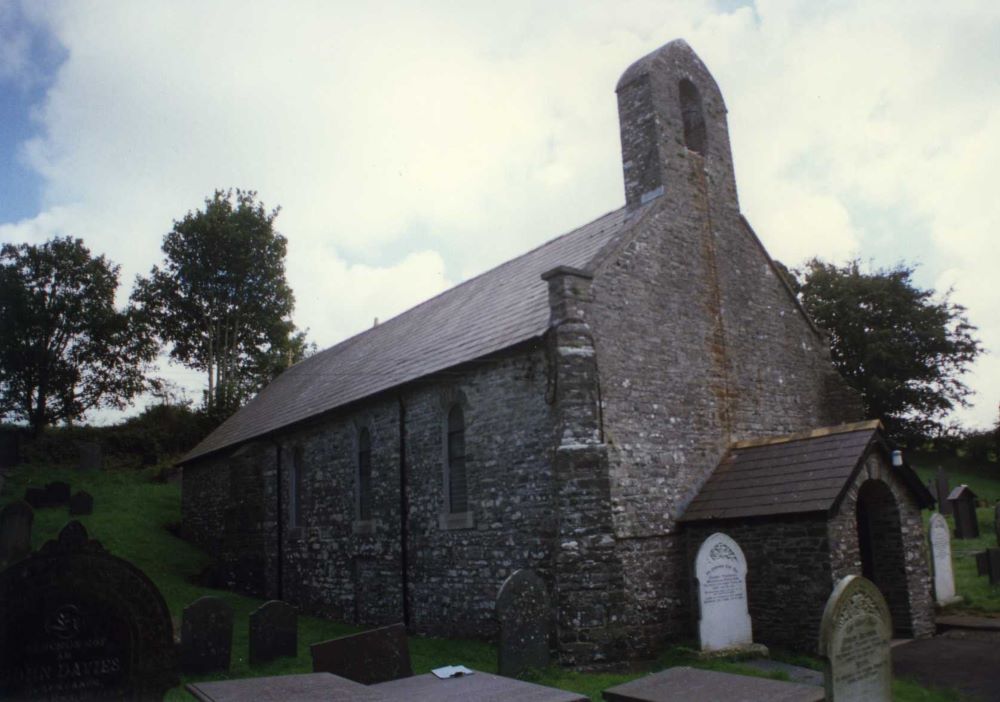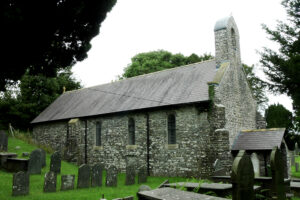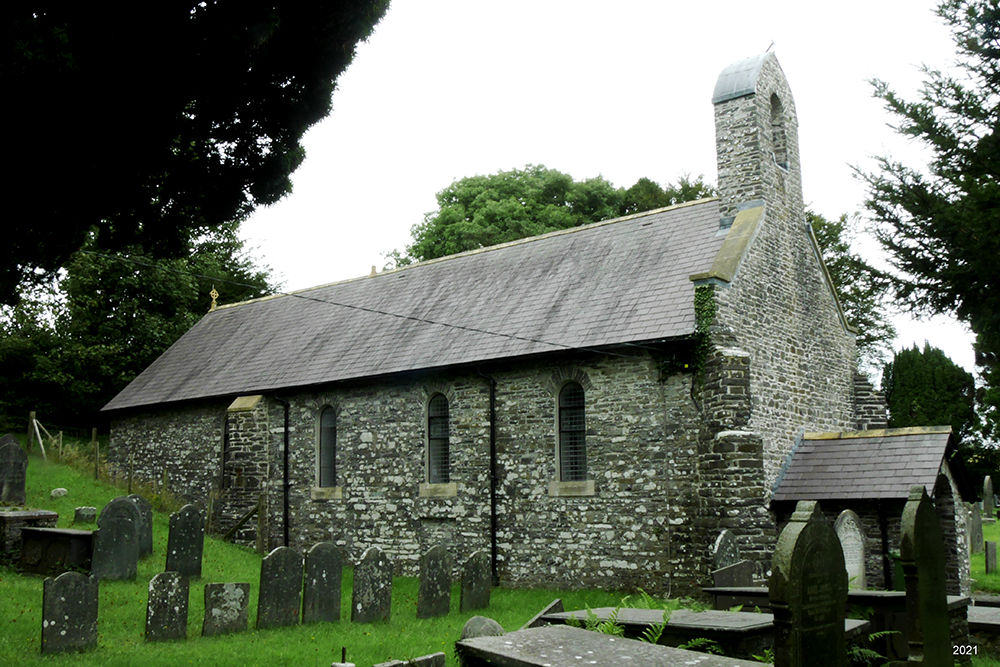

ST MICHAEL, CILIAU AERON, CEREDIGION
Dyfed PRN 20737
RB No. 3684
NGR SN 5024 5814
Listed Building no. 9763
Grade II listed (1998)
First Listed in 1964. Last amended in 1996.
Reasons for Listing: Rare example in the region of mid C18 church. Highly attractive setting.
SUMMARY
Mid 18th century church; 0% pre-19th century core fabric. On site of, and possibly in same location as, medieval church (PRN 4853).
A 2-cell church, small. Consists of chancel/nave, 5 bays, mid 18th century. West porch, early 20th century. Local rubble construction. Slate gable roofs. Openings mainly from the mid 18th century, are without dressings and ‘Romanesque’ or neo-classical, including windows, doors, angle buttresses and western single bellcote; east window from 1905; porch door, early 20th century.
Roofs: mid 18th century, 1905 and early 20th century. Floors: 1905. Finishes: 1905?.
Condition – good.
Archaeological potential – good. No physical evidence for earlier church; deep, wide cutting around 50% of church, primary; external drain around 100% of church, secondary; no underfloor void; few external memorials significantly close to 50% of church .
Structural value (pre 19th century) – good. 90% pre-C19 core fabric.
Group value – medium. 18th century church; large attractive churchyard with good memorials.
Phasing:
Phase 1 – Chancel/nave, mid 18th century.
Phase 2 – Restored 1905, medium impact.
Phase 3 – West porch, early C20.
DESCRIPTION
St Michael, Ciliau Aeron, is a 2-celled church, of small-medium size. It was entirely (re)built in the mid 18th century on the same site and in the same location as its predecessor (PRN 4853), but nothing was retained from the earlier fabric.
The present church consists of a 5-bayed chancel/nave without structural division and a west porch. Construction is in local rubble throughout; dressed stone is confined to the east window where it is yellow oolite. The openings are mainly from the mid 18th century, semicircular-headed, semi-‘Romanesque’ or neo-classical and simple, the windows having timber frames; the east window is from 1905 and is a triple lancet. The simple west porch was added in the early 20th century, in similar style. There are stepped angle buttresses on the west end corners, and a similar buttress in the centre of both side walls. There is a simple, gabled single bellcote at the west end, with a semicircular-headed opening, mid 18th century. Roofs are slated gables. The mid 18th century collar-rafter roof still survives in the western half of the church; the eastern half was replaced in 1905. The tiled and flagged floors are from 1905 re-using earlier flags, and are not suspended. The internal panelling is pre-1905 (ibid.).
Nothing is known of the pre-18th century church; it apparently occupied the same site and location as the present church.
The present church was (re)built in the mid 18th century, at the expense of David Davies of Foelallt (d.1768) and recorded on his memorial in the churchyard. The floors were of wood and flags in 1905 (NLW, SD/F/118).
The church was restored in 1905 to the designs of the architect E. V. Collier, of Carmarthen (ibid.). The restoration was medium impact. The east wall and south-east corner were taken down and rebuilt, with a new east window. The east half of the church was reroofed. The church was refloored. A buttress was built against the north wall to match that on the south wall. A chimney was built at the west end (now gone) leading from a free-standing ‘Musgrave’ stove. The windows were repaired. The interior was reseated and plastered, and the panelling was repaired.
The west porch is apparently later (ibid.), but early 20th century.
The bell is medieval (Cadw, 1996, 48).
There is a no physical evidence for the pre-18th century church. There is a deep, wide cutting around the east half of the church, primary, revetted at the east end in 1905 (NLW, SD/F/118). An external drain runs all around the church, from 1905 (ibid.). There is no underfloor void. Few external memorials lie significantly close to the western half of the church.
The church was Grade II listed in 1998.
First Listed in 1964. Last amended in 1996.
SITE HISTORY
There no firm evidence for the pre-conquest religious use of the site.
St Michael, Ciliau Aeron, was not a parish church during the medieval period (Rees, 1932), but a chapelry of the medieval Deanery of Sub-Aeron. The benefice appears to have been a rectory (Anon., 1882, 201) belonging to St Davids Cathedral.
Ciliau Aeron had become a parish by 1833 when the living, a discharged rectory in the patronage of the Bishop of St Davids, was rated in the king’s books at £5 and endowed with £400 royal bounty (Lewis, 1833).
In 1998 St Michael, Ciliau Aeron, was a parish church. The living was a rectory, held with Llanerch Aeron, Dihewyd and Mydroilyn (Benefice 801) in the Archdeaconry of Cardigan, Rural Deanery of Glyn Aeron (St Davids, 1997-8).
The cult of St Michael has pre-conquest origins within Ceredigion; however, the Ciliau Aeron dedication may be later (Various, 1994, 393).
SOURCES CONSULTED
Map Evidence
Blaeu, J., 1648, Map of Cardiganshire.
NLW, Ordnance Survey 1:2500, Second Edition, Sheet XXV.1.
NLW, Parish of Ciliau Aeron, Tithe Map, 1843.
Rees, W., 1932, South Wales and the Border in the XIVth century.
Church in Wales Records
Hook Mason, 1994, Quinquennial Report, Ciliau Aeron.
St Davids, 1997-8, Diocesan Year Book.
NLW, SD/F/118, Faculty – Restoration of church, 1905.
Printed Accounts
Anon., 1882, ‘Historical MSS Commission’, Archaeol. Cambrensis, Vol XIII, Fourth Series.
Cadw, 1996, Buildings of Special Architectural Interest (Dyffryn Arth and Ciliau Aeron, Ceredigion).
Evans, G. E., 1917, ‘Cardiganshire: Its Plate, Records and Registers’, Archaeol. Cambrensis, Vol XVII, Sixth Series.
Lewis, S., 1833, A Topographical Dictionary of Wales.
Salter, M., 1994, The Old Parish Churches of South West Wales.
Various, 1994, ‘The Church in Ceredigion in the Early Middle Ages’, in Davies, J. L., and Kirby, D. P. (eds.), Cardiganshire County History Vol. I.
Up dated – September 2021 – PKR


